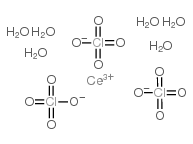14017-47-1
| Name | cerium(3+),triperchlorate |
|---|---|
| Synonyms |
Cerous perchlorate
Perchloric acid,cerium(3+) salt EINECS 237-836-2 MFCD00150205 Cerium(3+) perchlorate CERIUM PERCHLORATE cerium(3+) triperchlorate |
| Density | 1.501 g/mL at 25 °C |
|---|---|
| Molecular Formula | CeCl3H12O18 |
| Molecular Weight | 546.55900 |
| Exact Mass | 544.81400 |
| PSA | 278.19000 |
| LogP | 0.25710 |
| Appearance | crystal | white |
|
Version 1.2
Regulation (EC) No 1907/2006 1 - Product and Company Information Product NameCERIUM(III) PERCHLORATE, 99.5%, 40 WT. % SOLUTION IN WATER 2 - Hazards Identification SPECIAL INDICATION OF HAZARDS TO HUMANS AND THE ENVIRONMENT Contact with combustible material may cause fire. Irritating to eyes, respiratory system and skin. 3 - Composition/Information on Ingredients Product NameCAS #EC noAnnex I Index Number CERIUM(III) PERCHLORATE, 99.5%, 14017-47-1 237-836-2 None 40 WT. %SOLUTION IN WATER FormulaCe(ClO4)3 Molecular Weight 438,4700 AMU 4 - First Aid Measures AFTER INHALATION If inhaled, remove to fresh air. If not breathing give artificial respiration. If breathing is difficult, give oxygen. AFTER INGESTION If swallowed, wash out mouth with water provided person is conscious. Call a physician. 5 - Fire Fighting Measures CONDITIONS OF FLAMMABILITY May accelerate combustion. EXTINGUISHING MEDIA Suitable: Water spray. SPECIAL RISKS ALDRICHwww.molbase.com Specific Hazard(s): Emits toxic fumes under fire conditions. May accelerate combustion. Contact with other material may cause fire. SPECIAL PROTECTIVE EQUIPMENT FOR FIREFIGHTERS Wear self-contained breathing apparatus and protective clothing to prevent contact with skin and eyes. 6 - Accidental Release Measures PERSONAL PRECAUTION PROCEDURES TO BE FOLLOWED IN CASE OF LEAK OR SPILL Evacuate area. PROCEDURE(S) OF PERSONAL PRECAUTION(S) Wear self-contained breathing apparatus, rubber boots, and heavy rubber gloves. METHODS FOR CLEANING UP Cover with dry lime or soda ash, pick up, keep in a closed container, and hold for waste disposal. Ventilate area and wash spill site after material pickup is complete. 7 - Handling and Storage HANDLING Directions for Safe Handling: Do not breathe dust. Do not get in eyes, on skin, on clothing. Avoid prolonged or repeated exposure. STORAGE Conditions of Storage: Keep tightly closed. Store in a cool dry place. Unsuitable: Do not store near, nor allow contact with, clothing and other combustible material. 8 - Exposure Controls / Personal Protection ENGINEERING CONTROLS Use only in a chemical fume hood. Safety shower and eye bath. GENERAL HYGIENE MEASURES Wash thoroughly after handling. Wash contaminated clothing before reuse. PERSONAL PROTECTIVE EQUIPMENT Special Protective Measures: Wear appropriate government approved respirator, chemical-resistant gloves, safety goggles, other protective clothing. 9 - Physical and Chemical Properties pH N/A BP/BP RangeN/A MP/MP RangeN/A Flash PointN/A FlammabilityN/A Autoignition TempN/A Oxidizing Properties N/A Explosive Properties N/A Explosion LimitsN/A Vapor PressureN/A ALDRICHwww.molbase.com SG/Density1,5010 g/cm3 Partition Coefficient N/A ViscosityN/A Vapor DensityN/A Saturated Vapor Conc. N/A Evaporation RateN/A Bulk DensityN/A Decomposition Temp.N/A Solvent ContentN/A Water ContentN/A Surface TensionN/A ConductivityN/A Miscellaneous DataN/A SolubilityN/A 10 - Stability and Reactivity STABILITY Stable: Stable. Materials to Avoid: Organic materials, Finely powdered metals, Strong reducing agents. HAZARDOUS DECOMPOSITION PRODUCTS Hazardous Decomposition Products: Chlorine. 11 - Toxicological Information SIGNS AND SYMPTOMS OF EXPOSURE To the best of our knowledge, the chemical, physical, and toxicological properties have not been thoroughly investigated. Rare earth compounds may cause delayed blood clotting leading to hemorrhages. Inhalation of rare earths may cause sensitivity to heat, itching, and increased awareness of odor and taste. ROUTE OF EXPOSURE Inhalation: Material is irritating to mucous membranes and upper respiratory tract. Multiple Routes: May be harmful by inhalation, ingestion, or skin absorption. Causes eye and skin irritation. 12 - Ecological Information No data available. 13 - Disposal Considerations SUBSTANCE DISPOSAL Contact a licensed professional waste disposal service to dispose of this material. Observe all federal, state, and local environmental regulations. 14 - Transport Information RID/ADR UN#: 3098 Class: 5.1 PG: II Subrisk: 8 Proper Shipping Name: Oxidizing liquid, corrosive, n.o.s. ALDRICHwww.molbase.com IMDG UN#: 3098 Class: 5.1 PG: II Subrisk: 8 Proper Shipping Name: OXIDIZING LIQUID, CORROSIVE, N.O.S. Marine Pollutant: No Severe Marine Pollutant: No Technical Name: Required IATA UN#: 3098 Class: 5.1 PG: II Subrisk: 8 Proper Shipping Name: Oxidizing liquid, corrosive, n.o.s. Inhalation Packing Group I: No Technical Name: Required 15 - Regulatory Information CLASSIFICATION AND LABELING ACCORDING TO EU DIRECTIVES INDICATION OF DANGER: O-Xi Oxidizing. Irritant. R-PHRASES: 8-36/37/38 Contact with combustible material may cause fire. Irritating to eyes, respiratory system and skin. S-PHRASES: 17-26-36 Keep away from combustible material. In case of contact with eyes, rinse immediately with plenty of water and seek medical advice. Wear suitable protective clothing. 16 - Other Information WARRANTY The above information is believed to be correct but does not purport to be all inclusive and shall be used only as a guide. The information in this document is based on the present state of our knowledge and is applicable to the product with regard to appropriate safety precautions. It does not represent any guarantee of the properties of the product. Inc., shall not be held liable for any damage resulting from handling or from contact with the above product. See reverse side of invoice or packing slip for additional terms and conditions of sale. Copyright 2010 Co. License granted to make unlimitedpaper copies for internal use only. DISCLAIMER For R&D use only. Not for drug, household or other uses. ALDRICHwww.molbase.com SECTION 16 - ADDITIONAL INFORMATION N/A |
| Hazard Codes | O: Oxidizing agent;Xi: Irritant; |
|---|---|
| Risk Phrases | R8 |
| Safety Phrases | 17-26-36 |
| RIDADR | UN 3098 5.1/PG 2 |
| Packaging Group | II |
| Hazard Class | 5.1 |
